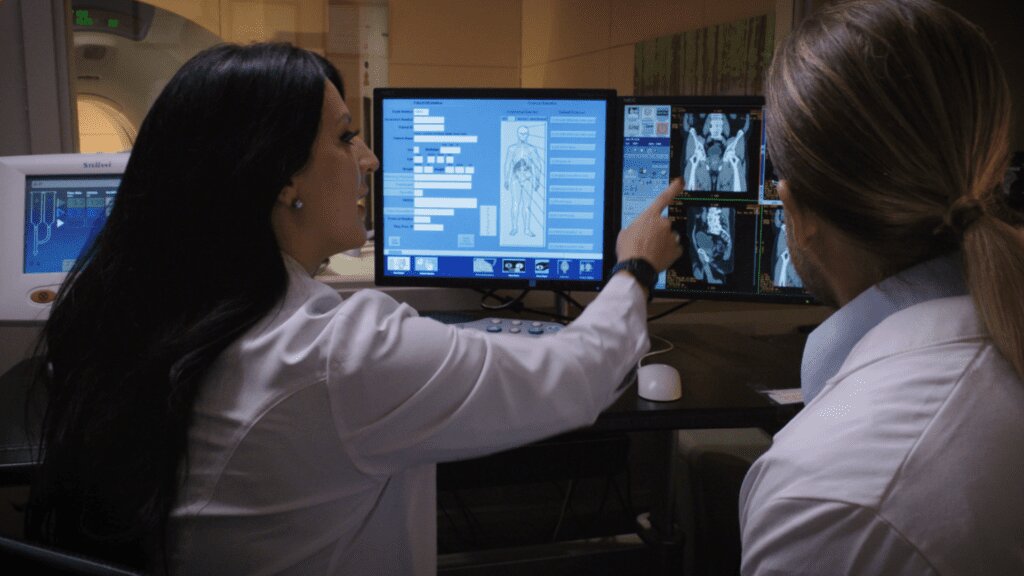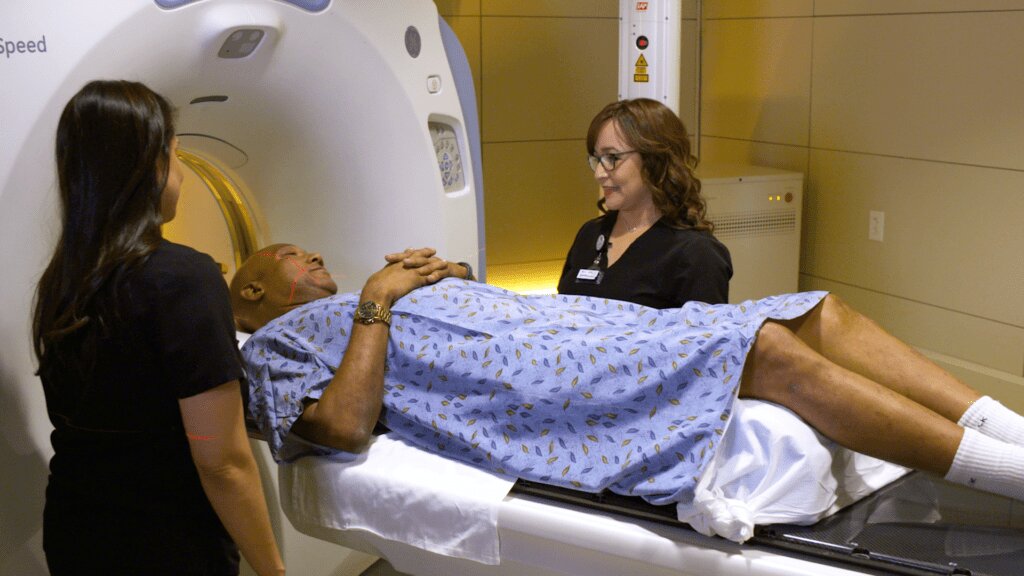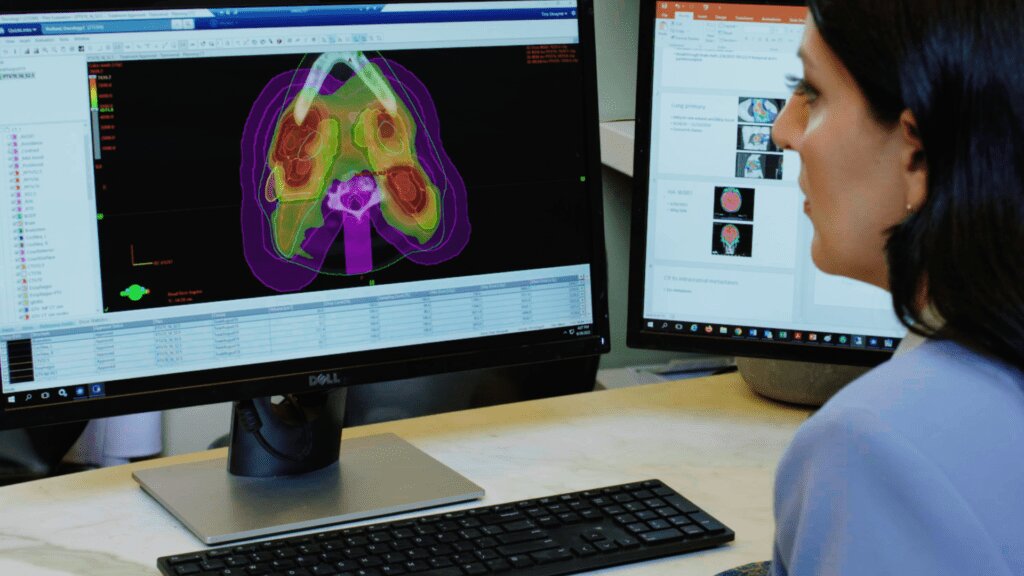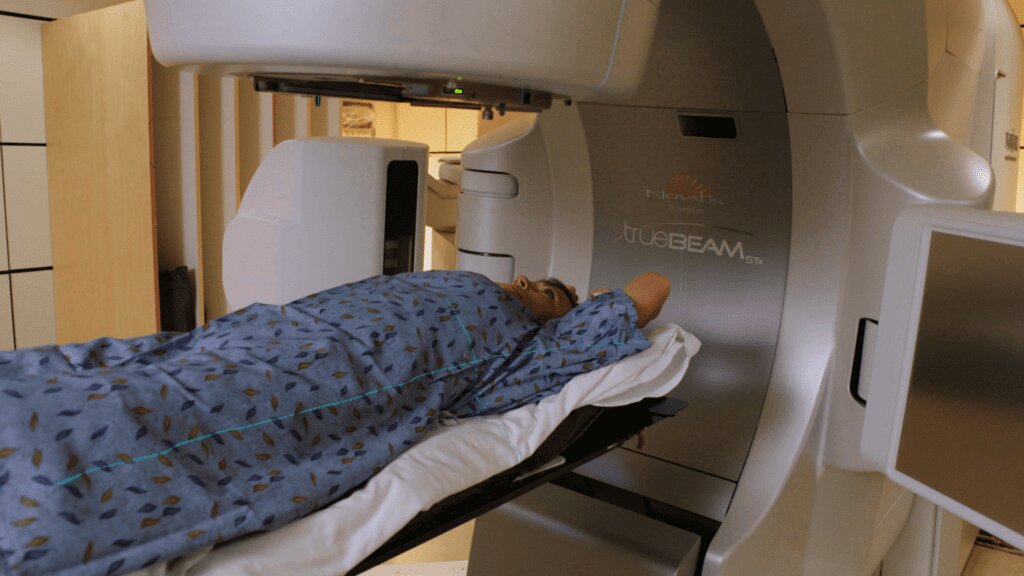What is Radiation Oncology ?
Radiation oncology is a branch of medicine that uses high energy x-rays to kill cancer cells. It uses a machine called a linear accelerator to direct radiation at cancerous and benign tumors.
Radiation can be given alone or with other cancer treatments, such as surgery, chemotherapy, or targeted therapies like immunotherapy.
The radiation damages the DNA of the cancer cells, which prevents them from growing and dividing. A patient cannot see or feel the radiation during treatment. The radiation beam is shaped, so it conforms to the shape of the tumor. This allows the radiation to target the cancer cells while sparing the surrounding normal tissues.
In order to shape the radiation beam, a 3D model of the target and the normal organs around it needs to be made. To do this, a “treatment planning” CT scan is performed. This CT scan is used to create a computer model of the tumor and the surrounding normal tissues. We call this process CT SIMULATION. The radiation oncologist then uses diagnostic imaging to determine the size, shape, and location of the tumor.

What We Provide
Our mission is to provide compassionate, state-of-the-art radiation therapy to our patients while maintaining the highest standards of quality and safety.
Our radiation oncologists work closely with surgeons and oncologists from all disciplines and in all practice locations throughout Tucson to provide you collaborative and comprehensive cancer care.
Radiation Therapy Treatment Process

Consult
- A. Initial meeting with physician
- B. Determine treatment plan

CT Simulation
- A. Planning session where we will create a setup custom made for you
- B. Includes a CT scan and creation of custom immobilization devices

Treatment Planning
- A. Physician outlines the area to be treated
- B. Our team, including Dosimetry and Medical Physics, creates a custom treatment plan.
- C. Quality Assurance is performed

Treatment
- A. Dependent upon your case, you may be treated daily, every other day, or just once.
- B. During your treatment course, you will see the physician weekly.
Treatment Options
There are two types of radiation therapy – External Beam Radiotherapy (EBRT) and Brachytherapy (BT). Brachytherapy is when a radioactive source is implanted inside the body for a specific of time. We do not offer Brachytherapy services at this time.
Learn more about EBRT:
- External Beam Radiation Therapy
- Intensity modulated radiotherapy (IMRT) is a sophisticated computer inverse planning technique that allows us to focus and escalate the dose where appropriate, while avoiding healthy tissue. The most modern form of IMRT delivery is VMAT (Volumetric Modulated Arc Therapy). VMAT is a highly conformal treatment delivered continuously as the treatment machine rotates around the patient.
RapidArc Rotational Radiation Therapy (RapidArc) brings together the most sophisticated techniques (IMRT, IGRT, CBCT, OBI) to deliver the radiation in quick, smooth arcs using a single rotation of the head of the machine (gantry). Delivery for one treatment is usually 90 seconds whereas conventional IMRT can take 4-8 minutes to deliver therapy. It is exceptionally precise and can be thought of as IMRT-arc-therapy. We utilize this technology at Radiant Oncology.
Stereotactic Body Radiation Therapy (SBRT) is a form of external beam radiation which delivers high doses of radiation to small targets over the course of 2-5 treatments. This is commonly used in the lung, but can be used anywhere in the body. The radiation dose falls off rapidly in order to protect healthy tissue around the target.
Stereotactic Radiosurgery (SRS) is a form of EBRT which delivers high doses of radiation to small targets in the brain or spine in a single treatment. The radiation dose falls off rapidly in order to protect healthy tissue around the target. The delivery of SRS at Radiant Oncology is overseen by a Neurosurgeon, a Radiation Oncologist, and a Medical Physicist.
Palliative Radiotherapy: Palliative Radiotherapy is primarily utilized to manage symptoms (pain, bleeding), and alleviate compression of critical organs. These treatments improve quality of life.
- Image Guided Radiotherapy (IGRT) is a general term that can include the utilization of daily CT scan (cone beam CT / CBCT) or daily x-ray (On-Board-Imaging OBI) to image a target prior to delivery.
Surface Guided Radiation Therapy (SGRT) is a system used to track the patient’s skin surface / body contour in real time to ensure the patient doesn’t move during radiation delivery. This makes treatment safer and more comfortable for patients.
- AlignRT is the system we utilize; it is equipped with infrared cameras that monitor the patient’s skin surface and pause the machine automatically if the patient moves out of the correct position. This gives us sub-millimeter precision and allows us to avoid the use of traditional closed face masks.
